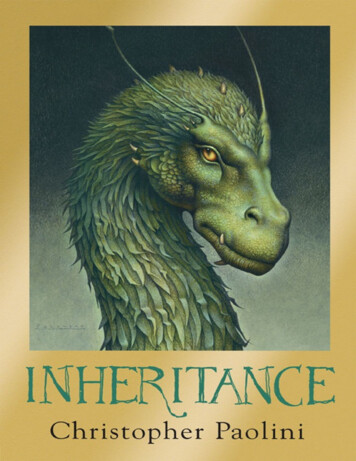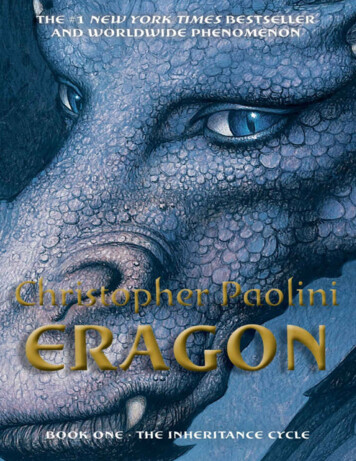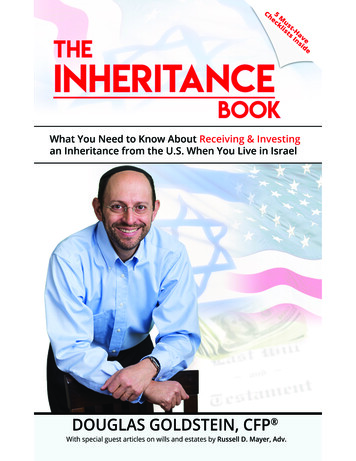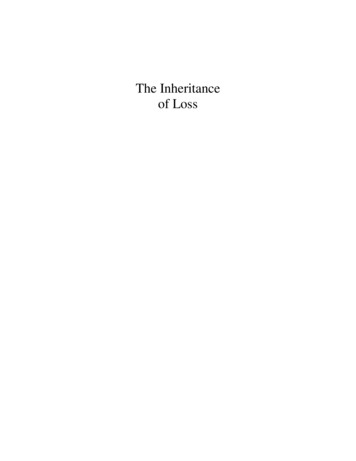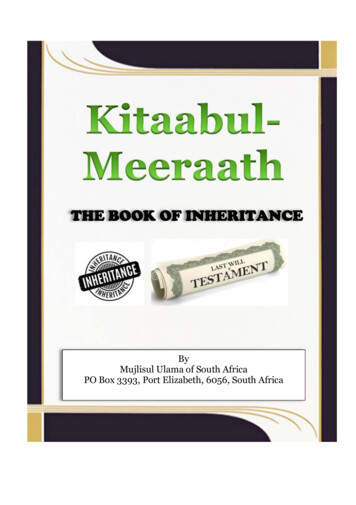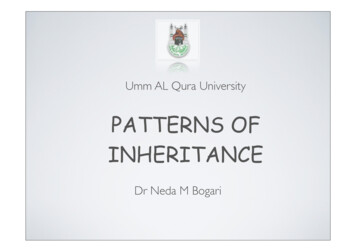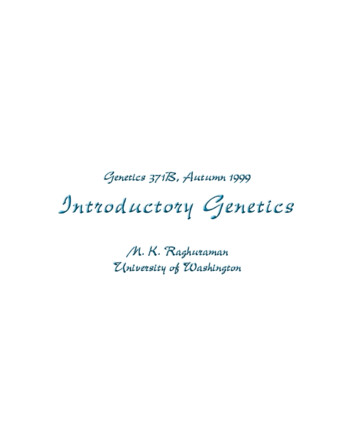
Transcription
Introduction – Mendelian inheritanceGenetics 371B Lecture 127 Sept. 1999The mechanism of inheritance Some early hypotheses:Predetermination e.g., the homunculus theoryBlending of traitsIntroducing a more systematic approach Gregor Mendel (1822–1884) and hisexperiments with garden peaBut first:Choosing a model organismWhat is it?Why bother?
Features of a good model organism:Some commonly used model organisms:
Mendel's organism of choice: garden peaHis question: If a pair of plant lines showing aclear character difference are crossed, will theprogeny show an intermediate phenotype?He established true-breeding lines that showed character differences
Made crosses (matings) between each pair of linesExample:Character:Phenotypes:x“F1”F1 x F1“F2”
Mendelian Genetics – Monohybrid crossGenetics 371B Lecture 228 Sept. 1999Interpreting Mendel’s experimentParents:Gametes:F1 progeny:Gametes:F2 progeny:
Conclusions:1. Determinants are particulate2. They occur in pairs; one member may bedominant3. Determinants segregate randomlyinto gametesPrediction: The F2 “Purple” class consists of twosubclasses:Testing the prediction:What Mendel did:
What we would do today (hindsight!):Generality of Mendel's first law:(Not just for pea plants!)Fruit fly (Drosophila melanogaster)Normal (brown) body x black body
MiceAgouti x BlackHumansAlbinism
Pedigree analysisWhat are pedigrees?Why bother with them?Constructing pedigrees“The inability to smell methanethiol is a recessive trait in humans. Ashley,Perry, and Gus are three smelling children of Erin (a non-smeller) andDarren (a smeller). Perry's only child is a non-smeller boy. Construct apedigree for this family, indicating the genotypes where possible.”To be continuedÉ
ComplicationsExpressivityPenetranceDo all human traits show simple Mendelianinheritance?
Commonly used pedigree eterozgygotes(autosomalrecessive)Parents andchildren (inorder of birth)Carrier, sexlinked dentical)twinsSexunspecifiedDeceasedStillborn orabortionProbandConsanguineousmarriage
Modified monohybrid ratiosGenetics 371B Lecture 329 Sept. 1999Snapdragon flower colorRed flowersxWhite flowersPink flowersBlending of determinants?How to test?Prediction?. . . a case of incomplete dominance
Incompletely dominant or recessive?. . . in the eye of the beholder?e.g., Tay Sachs diseaseSymptoms:extreme sensitivity to noisemuscle weaknesscherry-red spot on retinaAffected individuals rarely survive past childhoodDefect –Overt phenotype . . .At the biochemical level . . .
Co-dominancee.g., ABO blood groupThree possible alleles: A, B, or OLooking at 3 different “crosses”:AA x BBAA x OOBB x ype?
The curious case of the yellow miceNormal x Yellow mice1:1 Normal : YellowInterpreting:Which allele isdominant?Parental genotypes?Yellow x Yellow2:1 Yellow : NormalWhat’s missing inF2?
The physical basis of Mendelian genetics1902: Boveri and Sutton, “Chromosome theory ofinheritance”ChromosomesDiploid vs. haploid chromosome numberWhat’s in a chromosome?Protein
DNA (deoxyribonucleic acid)Subunit: Ribose Phosphate baseBase: Adenine, Cytosine, Guanine, ThymineDNA as the molecule of inheritanceThe Hershey-Chase experimentQuestion: What is passed on from one generationto the next, protein or DNA?Model organism: Bacteriophage T2
The experimentBacteriophage withradioactive DNABacteriophage withradioactive proteinInfect bacteria (E. coli)Do progeny virushave radioactiveDNA?Conclusion:Do progeny virushave radioactiveprotein?
The cell cycleGenetics 371B Lecture 41 Oct. 1999The structure of DNABackbonePairing5'3'3'AGTCTTCAGAphosphateribose sugar5'
What holds the helices together?Length measure (double-stranded DNA):Human genome:What are alleles?The cell cycle
DNA replicationA C C A T C G AT G G T A G C TCGATTAGCATCGGCGCCell division:What happens to the chromosomes depends onthe goal of the divisionto make more “vegetative” cells:to make gametes:
Mitosis – Partitioning replicated chromosomesGoodBad!or
The problem: Partitioning replicated chromosomesso that each daughter cell gets one copy of eachchromosomeThe solutionAfter replication of a chromosome hold the two sister chromatids togethertarget them to opposite polesthen separate the sisterscentromerereplicationA convenientrepresentation rememberthat chromosomes don’tcondense and take on thisform until Prophase (thestart of mitosis)sister chromatidsAt Metaphase . . .Chromosomes line up at cell’s “equatorial plate”Mechanism? Spindle fibers exerting tension onkinetochores
Once all the chromosomes are lined up AnaphaseTelophaseWhat kinds of defects would make mitosis go haywire?
Meiosis and the Chromosome theoryGenetics 371B Lecture 54 Oct. 1999Meiosis - making haploid gametes from e problem: ensuring that homologs arepartitioned to separate gametesThe solutionhold homologous chromosomes together bysynapsis and crossing overtarget homologs to opposite polesthen separate the homologs
Meiosis proceeds in two steps: Meiosis I — “reductional division” Meiosis II — “equational division”
Metaphase IMetaphase IIAnaphase I
The chromosome theory of inheritanceBased on the congruence of determinantbehavior (Mendel) and chromosomebehavior (cytology)The essence of the theory:Proof- Based on tests of predictions:transmission of traits should parallel the segregationof specific chromosomesif chromosome segregation is altered thetransmission of determinants should be altered also
Thomas HuntMorgan, 1909: Testof the first prediction - inDrosophilaRed eyeswhite eyesChromosomes ofDrosophila melanogaster:white eyesRedxxF1F1F2F2
Morgan’s interpretation:w w ww ww
Conclusion:Calvin Bridges’ experiments with exceptionalprogeny: Test of the 2nd predictionwhite eyesRedxExpect:Occasionally got:[“primary exceptionalprogeny”]Explanation?Rare errors in meiosischromosomesmis-segregation of
NormalMIM IIMIM IIAbnormalXeggsYspermXXOConclusions1. Determinants are on chromosomes2. In Drosophila, two X female(one X male)
Sex-linked inheritanceGenetics 371B Lecture 65 Oct. 1999Sex determinationFemale MaleFruit flyPossibilitiesYmaleXXfemaleHumansBirdsIn humans, the presence of a Y chromosomemakes a male:Klinefelter syndrome: XXYTurner syndrome: XO
How does the Y chromosome causemale-ness?“TDF” (testis-determining factor) aka SRY gene onthe Y chromosome X YA]]
Analyzing pedigreesThe processAn assumption:The resultExamplesFor each of the following pedigrees, can you decidewhether the trait is dominant or recessive?I12II12III123IV12
I12II1234545III12312678IV345Is this a recessive trait?I12II123
Sex-linked traitsX-linked recessiveConsider these pedigrees (to be filled in)X-linked dominant
What would you predict for a Y-linked trait?Sex-limited inheritancee.g., hen-feathering in chickenHen-feathered?GenotypeHHHhhh
Sex-influenced inheritanceMahogany Red4xRed Mahogany4
For each of the following pedigrees, which modes ofinheritance can you eliminate, and why? (Assumecomplete expressivity and penetrance; also assumethat the trait is rare and that unless indicatedotherwise, there is no inbreeding.)(A)I12II1212344556III3678IV12345
345678910111234567891011IV
(D)I12II123123124567III45678IV34567
Independent assortmentGenetics 371B Lecture 76 Oct. 1999Based on what we know about meiosis expectrandom segregation of chromosomesEvidenceMeiosis in grasshopper testesOne heteromorphic chromosome pair; oneunpaired chromosomeAs predicted for random segregation:
Therefore expect that segregation ofdeterminants on different chromosomesshould be independent of each otherMendel’s experiments cont’d PGametesF1Gametes
Segregation of alleles of one gene is independent ofsegregation at another gene — law of independentassortmentBranch diagrams – consider one phenotype at atime; overall ratio is product of individual ratiosRrYy x RrYyAaBbEeYRBAybx AaBbEeEeEeEBYrayeEbe
Predicting the results of crosses For any multi-factor cross showing independentassortment –How many gamete classes?How many progeny phenotypes?How many progeny genotypes?
Need:to be able to predict genotype/ phenotypes ratioslarge sample sizessystematic way of evaluating whether theobserved results are really different from theexpected results
ProbabilityGenetics 371B Lecture 88 Oct. 1999Predicting outcomesThe goal: Estimating the chances of a particularoutcome actually occurringWhy bother?Consider this pedigree:AaAa12Is II-1 female or male ?How probable is eachoutcome?III?1?234Is II-4 A or aa ? Howprobable is each genotype?
Probability:of an inevitable event of an impossible event If x, y, and z are the only possible outcomes of anevent, P(x) P(y) P(z) Imposing multiple conditionsProduct ruleThe probability that two or more independentevents will occur (event x and event y and )Examples
What is the probability that III-1 will be aa ?I12AaII1III23?1Relaxing the criteriaSum ruleThe probability of an outcome that can be achievedby more than one way (event x or event y or )When you pick a card probability that it is ared 5 ?
Probability that III-1 is homozygous ?I1AaII1III223?1
Probabilities of sets of outcomesBinomial expansion to determine the probability of a specific set ofoutcomes in a number of trials that could each haveeither of two possible outcomese.g., determining the probability of 1 female and 4male children in a family with 5 childrenEquation:(a b)5 1a5 5a4b 10a3b2 10a2b3 5ab4 b51. Find the term where the exponents match thenumbers you want2. Substitute the individual probabilities fraction of 5-children families expected to have 1daughter and 4 sons:
Evaluating results Assessing the goodness of fit2 analysis – How likely is it that the deviationfrom the predicted values is due to chance alone?Null hypothesis – that there is no real differencebetween observed and predicted resultsExample: flipping a coin to decide if it’s a trickcoin 2 analysis:1. Compute χ2 value:2 (observed - expected)2expected
2. Determine df (the # of degrees of freedom)3. Look up P value in χ2 table
Exercise:Are the results of this Drosophila cross consistentwith independent assortment of the two genes (sv and spa )? Can you explain these results? [Hint:refer back to the chromosome theory of inheritance.]sv svspa spa# of progeny759xsvsvspaspaPhenotype of progenysv spa 2sv spa0sv spa 770sv spaRemember that sv and spa are the dominantphenotypes; sv and spa are recessive.
Chi-square 9l0
Linkage and recombinationGenetics 371B Lecture 912 Oct. 1999Explanation for the Drosophila cross (lecture 8 end): but how to explain the results of this Drosophilacross?[pr purple eyes; vg vestigeal wingsBoth are recessive alleles; “ ” alleles are wildtype]pr prsc scpr sc 1339pr sc151xpr pr sc scpr sc 154pr sc1195
Morgan’s explanation, based on cytology of meiosis–recombinant class arising from crossoverHow to test? What’s needed?Harriet Creighton & Barbara McClintock, maizeCurt Stern, Drosophila
Experimental setup:RarAraxrAR colored endospermr colorlessA starchy endosperma waxyNote the two salient features that make this experiment feasible:“knob” and translocation –genetic markers –Look for colorless, waxyprogenyAsk: what do the chromosomes look like in theseprogeny?
Their results:Importance of crossovers?proper segregation of homologsnew combinations of allelesMapping genesAa Bb x aa bb5002020500ABAbaBabAa Dd x aa dd4206060430ADAdaDadAa Ee x aa ee350120120350AEAeaEaeCan you deduce the map order of these genes?
Insight from Alfred Sturtevant (1913)—If recombination sites are random,probability of recombination between a pair ofgenes recombination probability in adjacent intervals Recombination frequency can be used as ameasure of genetic map distance1 map unit 1 centiMorgan 1% of meioticproducts being recombinant
Constructing genetic maps1. Are the loci linked? (What is a locus anyway?)2. How much recombination?How do we identify the recombinant gameteclasses?ParentRecombinant gametes*AABabAabb&aBAB&Ba*Fill out the worksheet to be sure you understand thisb
Operational definition for “non-parental”:Generally, the cross isheterozygote x homozygous recessive why?
Meiosis worksheet1. No recombination between A/a & B/bABab2. Recombination between A/a & B/bABab3. No recombination between A/a & B/bAbaB4. Recombination between A/a & B/bAbaB
Gene mapping - I: Three-point test crossGenetics 371B Lecture 1013 Oct. 1999What is the maximum recombination frequency in anyinterval?The range of possibilities:Tightly linkedIndependent assortmentUnlinked loci:Loci can appear to be unlinked because:
3-point test cross – what is it; why do it?Requirements for successful 3-point test cross:Triply heterozygous strain (producer of recombinantgametes)A cross that will reveal the genotypes of thegametes Example 1. Predict the progeny phenotypesand numbers for this crossParent 1: ab c Parent 2:b c ab c aBC3 cMA7 cM count 10000 progeny
Step 1. Determine the phenotype and number of thedouble-crossover (DCO) productsStep 2. Determine the phenotype and number of thesingle-crossover (SCO) productsStep 3. Determine the number of the parental (noncrossover, NCO) types
Example 2. Construct a linkage map (order anddistance) for the following genesGenes:cu (curled wing)sr (stripe body)st (scarlet eye)Parents:Female:Male:cn/ cn/cnProgeny phenotypes:cn vgrdcn rdvgcn rd vg rd vgcn420242582832264276482458rd/ rd/rdvg/ vg/vg
Step 1. Identify the parental, SCO and DCO classesStep 2. Determine the gene order—Knowing the allele composition of the parental class, whatgene order could generate the observed DCO classes? (Trialand error!)Step 3. Add up the recombination frequencies toobtain the map distances
Genetic maps may not correspond directly to physicalmapsWhat could cause the genetic map to deviate from thephysical map?Map expansion:Map contraction:Interference and coefficient of coincidence
Gene mapping - II: Somatic cell hybrids and FISHGenetics 371B Lecture 1115 Oct. 1999GenomicsGenetic maps in humansThe trouble with humans MarkersCrossesEstablishing linkage: which chromosome?Recognizing chromosomesSizeStaining pattern – bands
Somatic cell hybridsmouse cellhuman cellpolyethylene glycol or inactivatedSendai virushybrid cellrare event!Elimination of most humanchromosomesHybrid cell lines: mostly mouse plusa few human chromosomes
How to pick out those rare fusion events? selection based on DNA precursor synthesisTwo pathways of DNA precursor synthesis:De alvagesynthesisHGPRTTKTo select fusion product mouse cellhuman cellhybrid cell
Fluorescent in situ hybridization (FISH)Hybridize fluorescent-labeled probe to chromosomespread can be used in combination with somatic cell hybrids
Mapping by linkage linkage with respect to what?The conventional approach – look atrecombination frequency between the gene of interestand a neighboring marker geneConventional markers (alleles that result in overtphenotypes) are hard to come by But DNA sequence differences (polymorphisms) areplentifulTherefore: construct a map of polymorphic sites
To map a gene: look at recombinationfrequency between the gene of interest and aneighboring polymorphic site so, we use DNA sequence polymorphism as justanother pair of alleles – without an overt phenotype,but detectable
Useful polymorphismsOriginally – Restriction fragment lengthpolymorphisms (RFLP)These days – Sequence repeat polymorphismsRepeated sequences constitute up to 35% ofthe human genomeMinisatellite repeats: 30 bpMicrosatellite repeats: 2–5 bpDispersed throughout the genomeHighly variable numbers of repeats at each location;individuals often heterozygous
Gene mapping - III:Genetics 371B Lecture 12Human DNA marker maps18 Oct. 1999What’s polymorphic about microsatellite repeats?Chr 7Person 1Person 221 repeats on chromosome 7 homolog 133 repeats on chromosome 7 homolog 230 repeats on chromosome 7 homolog 118 repeats on chromosome 7 homolog 2The advantage of microsatellite repeats:
Map construction: Identifying repeats and theirgenomic locationsStep 1. Make genomic library of short inserts(Cut with 4-base cutter)vectorligatetransform E. colilibrary
Step 2.Identify repeat-containing clonesSynthesize DNA for probe:e.g., (CA)20probe thelibraryidentify positivessequence the insertsClone 1 ACGGTTTCGGTGGTTAATTTAGCT Clone 2 CACACACACACACAGTTTGATTATTGCTACTTAC etc.
Step 3. Identify chromosomal locations of therepeat sequencese.g., by hybridization to metaphase chromosomes(somatic cell hybrids come in handy!)Step 4. Constructing a profile: How many alleles inthe population? How frequent?Usually done by Polymerase ChainReaction (PCR)
Determining repeat number at apolymorphic locus PCR using unique sequence (flanking the repeat) asprimersUsing our chromosome 7 example again:Primer 121 repeats33 repeats31 repeats18 repeatsPrimer 2gel electrophoresis12
Using polymorphisms to map disease genesScore disease gene allele based on overt phenotypeScore polymorphic alleles based on PCR analysisAsk: can recombinants be detected?In practice:Obtain DNA sample from all family members(bloodtissue culture)For each individual:score disease phenotype, determine genotypescore polymorphism on each homolog (e.g.,21,33) for each of many polymorphismsFor each polymorphism, calculate Lod score forvarious map distancesLod score log of odds of linkage log10likelihood of linkagelikelihood of not being linked
Gene mapping - IV: Linkage maps, positional cloningGenetics 371B Lecture 1319 Oct. 1999Computing LOD scores –Take a pairwise combination of disease gene and apolymorphic locus Ask:What’s the probability of getting this pedigree ifthe two loci are linked What’s the probability of getting this pedigree ifthe two loci are unlinked?Calculate LOD scoreRepeat
A hypothetical example –54LOD score (Z)3210-110 20 30 40 % Rec-2-3Lod score of 3 95% probability of linkage atthe proposed recombination frequency
From Lod scores – sites with highest probability oflinkage to the geneLod scores from different pedigrees can be addedup!Why?Linkage to marker sites – can be starting point forcloning the gene Positional cloningNot trivial – 1–2 cM still 1–2 million bp to search!Approaches to cloning the gene“brute force”
Candidate gene approachrescue of disease phenotype in a modelsystem
Other applications of polymorphic sitemapping technologyDiagnosticsDNA profiling/genetic fingerprintingTabulate allele frequencies for various polymorphicsites – e.g.,Polymorphic site 1: 20 alleles (21-40 repeats), equalfrequenciesPolymorphic site 2: 30-40 30 repeats)(31 repeats)(32 repeats)(33 repeats)(34 repeats)(35 repeats)vii.viii.ix.x.xi.xii.0.05 (36 repeats)0.10 (37 repeats)0.09 (38 repeats)0.13 (39 repeats)0.08 (40 repeats)0.08 (all others)What is the probability of a person having alleles ii and ivof polymorphic site 1, and alleles v and ix ofpolymorphic site 2?
Some applications of DNA profilingForensicsPaternityConservation biology
Mutations and mutagenesisGenetics 371B Lecture 14What is a mutation?Chromosome mutationsPoint mutationsBase substitutionsInsertions/deletions—frameshift mutationsIs a mutation an allele?22 Oct. 1999
Where can things go wrong?Drosophila yellow gene400 bpNucleusCytoplasmAAGUGCA AUGUUCCAGGACAAAGGGUGGAUCCUU CAAGGUUAACAUA
Mutation frequencyH. J. Muller’s assay – How frequently does theDrosophila X chromosome acquire mutations?w wxww w w[w white-eyed]Asked what fraction of crosses failed to givered-eyed male progeny?Conclusion: 2 mutations per 1000X chromosomes
Extrapolating to humans Inbreeding, and why it’s not a great idea
Some causes of mutationsMisincorporation during replicationExternal causesRadiationChemical mutagens – e.g.:Alkylating agentsHH NON HNNNN HNCH3OCH3CH2-ONOHIntercalating agentsNNH NNNN HHON
Damage controlPreventing misincorporation –Normal activities of polymerase:Extension of 3' base-paired primerRemoval of 3' unpaired baseIf incorrect base is put in Correcting misincorporation –Mismatch repair:1. Identify mismatched bases2. Identify the original (parental) strand3. Correct the other strand
Timeout for repair – CheckpointsLee Hartwell and Ted Weinert, UW (1989)checkpointproteinPhenotype of mutant?cell cycle
Cytogenetics - I: Changes in chromosome structureGenetics 371B Lecture 1525 Oct. 1999Chromosomal abnormalitiesChanges in chromosome numberChanges in chromosome ionsWhat’s the tolerance limit for “gene imbalance” ?
DeletionsTerminal vs interstitial“cri du chat” syndrome in humans –terminal deletion in chr 5How are these deletion chromosomestransmitted?Genetic consequencesReduced recombination frequency betweenmarkers flanking the deletionaabb
Recessive alleles uncoveredab cdef Practical use: deletion mapping tolocate genesSet up crosses such that the progeny havethe recessive allele of interest on onehomolog and a deletion on the other ask:which deletion uncovers the recessiveallele?aaa aa Phenotype
DuplicationsLarge-scale – e.g.,Charcot-Marie-Tooth syndromechr 17Microscopic/submicroscopicCan be caused by unequal sisterchromatid exchange – e.g., one form ofred-green color blindnessreplication
Trinucleotide repeat expansione.g., Huntington diseaseFragile X syndromeMyotonic dystrophy(CAG)nFor Huntington Normal n 9 - 3030 – 35 "premutation" 36 : diseaseAge of onset a number of repeatsRepeat # 4041424344-4546-4950-55 56Age of onset42-8430-6635-5923-6122-5421-4820-447-23
“Anticipation” – progressively earlier onset18,1736,2017,15 18,4121,16 17,4417,46 17,1817,21 21,48 17,16Mechanism of disease?Mechanism of expansion?
Cytogenetics - II: Structural changes, cont’dGenetics 371B Lecture 1626 Oct. 1999InversionsFrom two internal breaksPhenotypes?Often no overt phenotypeInitial detection often on genetic groundsParacentric and pericentric inversionsNormalParacentricPericentric
Meiosis and crossing over in inversionheterozygotesMarkers on the homologs are no longer colinear Paracentric inversions
Consequences?Pericentric inversions
Consequences?TranslocationsOften reciprocalDouble heterozygotes can be viablePhenotypes– can cause some serious human disordersAssociated with specific forms of cancere.g., Burkitt lymphomaone partner: chromosome 8other partner: chromosome 14, 22, or 2814
Non-cancer disorderse.g., translocation Down syndromeRobertsonian translocation betweenchr 14 and 21long arms of two acrocentric chromosomes fusedTranslocation event2114Translocation carriermeiosisGametes from normal parent
Pairing and meiosis in double heterozygotesNormalTranslocation (reciprocal)AdjacentAlternateor
ConsequencesSemisterility
Cytogenetics III: Changes in chromosome numberGenetics 371B Lecture 1727 Oct. 1999Euploid: normal chromosome setsAneuploid: incomplete (unbalanced) chromosomesetsIn humans—aneuploidy in up to 35% of spontaneousabortions (6–20 weeks)Monosomy: 2n - 1Human (females) — only one kind of monosomy 1 in 20000 live births
Trisomy: 2n 1Most common (at conception ?)— chr 16Most common at live birth— trisomy 21 —Downsyndrome1 in 750 live birthsLess common:trisomy 18 (1 in 10000)trisomy 13 (1 in 20000)Why better survival with trisomy 21 thanother trisomies?Hierarchy of tolerance of aneuploidysex chromosome aneuploidy autosomalaneuploidy;autosomal triploidy monosomy
Major cause of aneuploidy:nondisjunction during meiosis can occur at Meiosis IConsequences:Defective productsAllele composition or at Meiosis II
Aneuploidy and maternal age1/12(patients per 1000 53035404550Maternal ageWhy?NDin older oocytes? Checkpoints?less robust spindle?increasing pool of “poor” oocytes?Estimated Down syndrome frequency100
About 20–25% of Down syndrome cases –paternal nondisjunctionAneuploidy from maternal or paternalnondisjunction? Sometimes, clues from the pedigree Xg X-linked recessive conditionPaternal or maternal ND here?Klinefelter (XXY) male
Mitotic nondisjunctione.g., Down syndrome mosaicsND in 1st cleavageND after 1st cleavageNormalND
Ploidy changesPlants: It’s not all bad news polyploidy is oftendesirablePolyploids largerInfertility due to polyploidyAnimals: Haploids, polyploids rareTriploidy in humans –
Dosage compensationGenetics 371B Lecture 1829 Oct. 1999Puzzling behavior of X-linked traitsDosage: Viability is extremely sensitive to genedosage so how to explain XX vs. XY?“Exceptional females”: X-linked traits notshowing the phenotype expected for the genotype –e.g., Becker-type muscular dystrophy, X-linkedrecessiveGenotype of II-2?Predictedphenotype:Actual phenotype:105
The Lyon hypothesis1949 – Murray Barr: “sex chromatin” in cells fromfemale mammals1959 – sex chromatin present in XXY males,absent in XO femalesXYXXXXYXO
1961 – Mary Lyon: inactive-X hypothesiscondensed X is genetically inactiveinactivation early in developmentinactivation independent and random ineach embryonic cell
Evidence supporting the hypothesis: correlatinglate-replicating X with inactive alleleFibroblast cells from female mule; look atexpression of G6PD gene Which X late-replicating?Which form of G6PD present?
Consequences of X chromosomeinactivation (explaining the puzzles):Dosage compensation – Only one Xchromosome genetically activeMosaic expression patternExample 1:dystrophy)the unexpected pedigree (Becker
Example 2: Making a calico catX-linked coat color geneRr Rr(early embryo)Rr RrCalico cat!
Mechanism of X chromosome inactivation?Selection of one X inactivation of the othersPropagation/maintenance of inactivestate
Dosage compensation in other speciesDrosophila: up-regulation of X-linked genesCaenorhabditis elegans: down-regulation of Xlinked genes
Mitotic recombinationGenetics 371B Lecture 192 Nov. 1999Rare relative to meiotic recombinationDiscovery: Curt Stern, 1936Linked genes singed bristles and yellow body ysn double heterozygote in transconfigurationExercise: Design an experiment toconfirm the trans configurationNormalOccasionally:or
Stern’s explanationNormal mitosisbut occasionally
Rare twin spots:*Exercise: This cell is shown to be undergoing mitotic recombinationafter completion of S phase (how can we tell from the diagram)?How can you tell from the products of the division that therecombination did indeed occur post-S phase?
Significance for human health?Suppose we’re talking about a recessive disease allele “Loss of heterozygosity”e.g., Retinoblastoma, Wilms tumor
Sporadic cases—Inherited form—Explanation?“2-hit kinetics”Rb /Rb Rb /rb“1-hit kinetics”Rb /rbrb/rbrb/rb
ApplicationsMapping – requency of "spots" proportionalto map distanceMapping centromeres – can you get twinspots?Caution:These aremitotic recombination frequencies!
Studying development, recessive lethal allelesAssay for genotoxic agents – “SMART”
Cancer genetics - IGenetics 371B Lecture 203 Nov. 1999PropertiesProliferationMetastasisDemonstration of the genetic basis ofcancer Can DNA from cancer cells transform normal cellsto cancer cells?
The experiment:Normal tissue culture cells:monolayerhuman bladdercancer DNACell foci –Loss of contact inhibition!Compare transformed cell DNA withnormal cell DNAsingle base change (GvalineT): glycine
Interpreting the experiment: Only asingle change to cause cancer?Multiple mutations needed ProgressionTumor growth
But what about the retinoblastoma example?Inheritance of oncogene – predisposition tocancer, not inheritance of cancerWhat does predisposition mean?Suppose a particular form of cancer requires 4mutations Mutation rate 10-5/cell generationProbability of all 4 mutations Cell divisions to make adult human 1014Probability of getting cancer If one mutation has already occurred (inherited):
Cancer – from mutations in:proto oncogenestumor suppressor genesDNA repair/maintenance genesNormalTumorsuppressor genesProtooncogenesCell growth andproliferationCancerTumorsuppressor genesOncogeneCell growth andproliferationTumorsuppressor genesProtooncogenesCell growth andproliferationMalignancy
Proto oncogenesGenes that promote cell proliferationOften involved with signal transduction andtranscription activationNucleusInappropriate activation – gain of function
Tumor suppressors – regulate cell proliferatione.g., E2F transcription factor: promotes G1phase transitionSHypothesis: Rb protein forms complex withE2F, preventing transcription RbE2Ftarget gene but phosphorylated Rb protein cannot bind toE2F proteinRbE2F RNApoltarget geneE2F binding siteinactivation – recessive loss-of-function
Cancer genetics - IIGenetics 371B Lecture 215 Nov. 1999Checkpoint defec
Introduction – Mendelian inheritance Genetics 371B Lecture 1 27 Sept. 1999 The mechanism of inheritance Some early hypotheses: Predetermination e.g., the homunculus theory B
